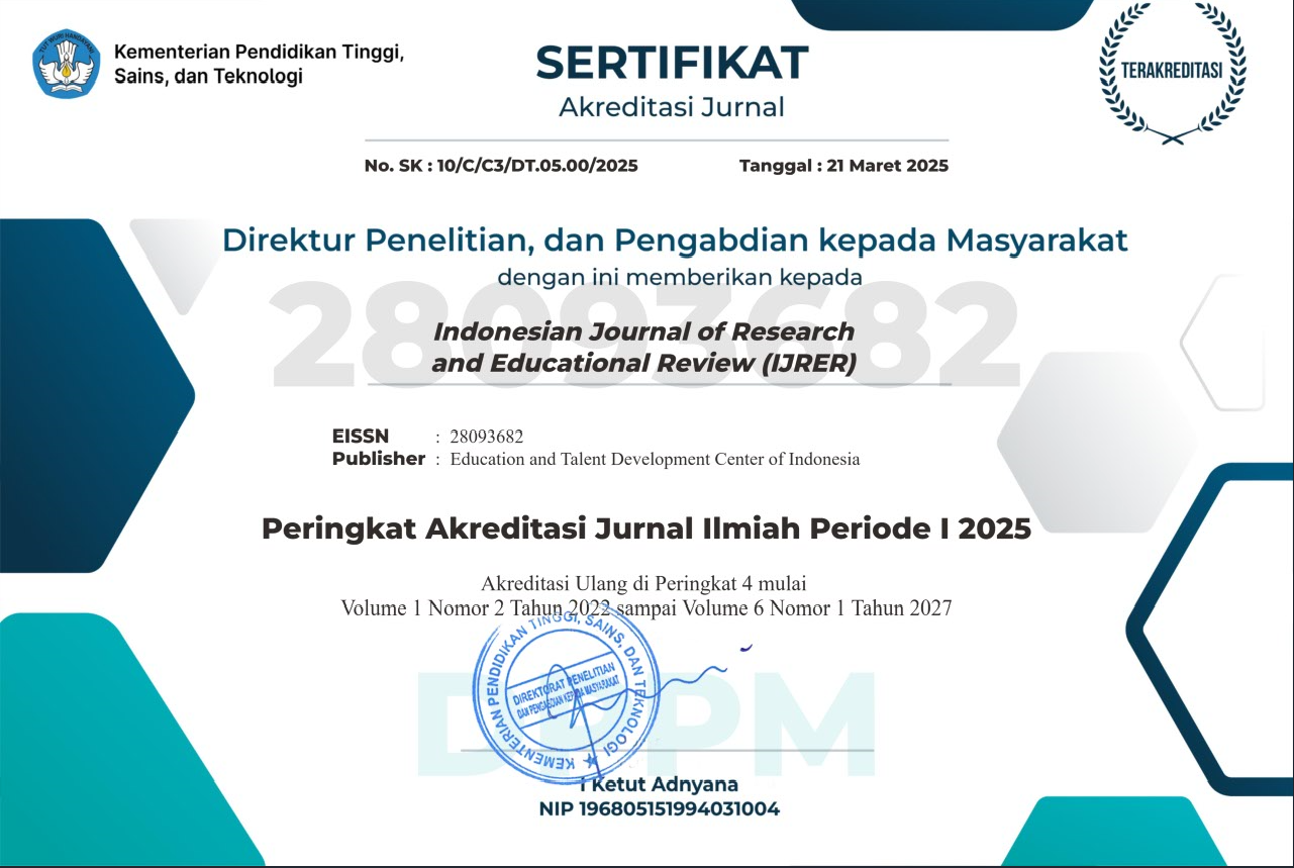Speaking Skills for English As A Foreign Language in Video-Based Discussion
DOI:
https://doi.org/10.51574/ijrer.v1i3.392Keywords:
EFL, Video-Based Discussion, Speaking SkillAbstract
This study focuses on determining if video-based discussions improve students' English-speaking abilities in their initial years at MTs As'adiyah Putra 1 Sengkang. Two classes served as the research sample in this study's true experimental design (the pretest-posttest control group design). There were 90 first-year students at MTs As'adiyah Putra 1 Sengkang in the population. 30 students served as the research's sample population. VII. A and VII. B was chosen as the sample for the research using the cluster random sampling approach, which was applied by the author. Speaking tests and the video-based discussion approach were used to gather data on the students' speaking abilities. The test's results were collated and put through a t-test and percentage analysis. As a result of the findings, it was determined that the probability value (0.00) was less than the threshold of significance (0.05) The examination of the data revealed that using video-based discussions to learn English considerably improves students' speaking abilities. The pre-test mean score is 1.9344, and the post-test mean score is 3.4817, which demonstrates this.
References
Al-Khresheh, M. H., Khaerurrozikin, A., & Zaid, A. H. (2020). The efficiency of using pictures in teaching speaking skills of non-native Arabic beginner students. Universal Journal of Educational Research, 8(3), 872-878. https://doi.org/10.13189/ujer.2020.080318
Amalia, R. (2017). Improving listening and speaking skills by using animation videos and discussion method. Pedagogy: Journal of English Language Teaching, 2(1), 30-36.
Babayiğit, S., & Shapiro, L. (2020). Component skills that underpin listening comprehension and reading comprehension in learners with English as first and additional language. Journal of Research in Reading, 43(1), 78-97. https://doi.org/10.1111/1467-9817.12291
Borko, H., Carlson, J., Mangram, C., Anderson, R., Fong, A., Million, S., ... & Villa, A. M. (2017). The role of video-based discussion in model for preparing professional development leaders. International Journal of STEM Education, 4(1), 1-15.
Broughton, G., Brumfit, C., Pincas, A., & Wilde, R. D. (2002). Teaching English as a foreign language. Routledge.
Campbell, D. T., & Stanley, J. C. (2015). Experimental and quasi-experimental designs for research. Ravenio books.
Changwong, K., Sukkamart, A., & Sisan, B. (2018). Critical thinking skill development: Analysis of a new learning management model for Thai high schools. Journal of International Studies, 11(2). https://www.ceeol.com/search/article-detail?id=718012
Chun, D., Kern, R., & Smith, B. (2016). Technology in language use, language teaching, and language learning. The Modern Language Journal, 100(S1), 64-80.
Cook, V. (2016). Second language learning and language teaching. Routledge.
Creswell, J. W. (2014). Qualitative, quantitative and mixed methods approaches.
Dalton-Puffer, C. (2007). Discourse in content and language integrated learning (CLIL) classrooms (Vol. 20). John Benjamins Publishing.
Ellis, N. C. (2019). Essentials of a theory of language cognition. The Modern Language Journal, 103, 39-60. https://doi.org/10.1111/modl.12532
Gan, Z. (2012). Understanding L2 speaking problems: Implications for ESL curriculum development in a teacher training institution in Hong Kong. Australian Journal of Teacher Education (Online), 37(1), 43-59.
Hartshorne, J. K., Tenenbaum, J. B., & Pinker, S. (2018). A critical period for second language acquisition: Evidence from 2/3 million English speakers. Cognition, 177, 263-277.
Hew, K. F., & Brush, T. (2007). Integrating technology into K-12 teaching and learning: Current knowledge gaps and recommendations for future research. Educational technology research and development, 55(3), 223-252. https://doi.org/10.1007/s11423-006-9022-5
Hung, H. T. (2015). Flipping the classroom for English language learners to foster active learning. Computer Assisted Language Learning, 28(1), 81-96.
Johar, S. (2015). Emotion, affect and personality in speech: The Bias of language and paralanguage. Springer.
John, E., & Yunus, M. M. (2021). A Systematic Review of Social Media Integration to Teach Speaking. Sustainability, 13(16), 9047. https://doi.org/10.3390/su13169047
Khan, R. M. I., Radzuan, N. R. M., Shahbaz, M., Ibrahim, A. H., & Mustafa, G. (2018). The role of vocabulary knowledge in speaking development of Saudi EFL learners. Arab World English Journal (AWEJ) Volume, 9.
Kiili, K. (2005). Digital game-based learning: Towards an experiential gaming model. The Internet and higher education, 8(1), 13-24.
Krashen, S. (2002). Theory versus practice in language training. In Enriching ESOL pedagogy (pp. 235-252). Routledge.
Kukuru, J. D. (2012a). Encouraging representation and involvement of learners on discussion method’s features towards ensuring effective teaching. Prime Research on education, 2(2), 180-190.
Kukuru, J. D. (2012b). Degrees of Representation of Features and Involvement of Learners in Discussion Method by Class Teachers. International Journal of Educational Sciences, 4(2), 175-186. https://doi.org/10.1080/09751122.2012.11890040
Leenknecht, M. J., Snijders, I., Wijnia, L., Rikers, R. M., & Loyens, S. M. (2020). Building relationships in higher education to support students’ motivation. Teaching in Higher Education, 1-22.
Le Fevre, D. M. (2003). 9. Designing for Teacher Learning: Video-Based Curriculum Design. In Using video in teacher education. Emerald Group Publishing Limited. https://doi.org/10.1016/S1479-3687(03)10009-0
Liu, D., Baumeister, R. F., Yang, C. C., & Hu, B. (2019). Digital communication media use and psychological well-being: A meta-analysis. Journal of Computer-Mediated Communication, 24(5), 259-273.
Mohammadi, J., Barati, H., & Youhanaee, M. (2019). The Effectiveness of Using Flipped Classroom Model on Iranian EFL Learners' English Achievements and Their Willingness to Communicate. English Language Teaching, 12(5), 101-115.
Namaziandost, E., Homayouni, M., & Rahmani, P. (2020). The impact of cooperative learning approach on the development of EFL learners’ speaking fluency. Cogent Arts & Humanities, 7(1), 1780811. https://doi.org/10.1080/23311983.2020.1780811
Oakhill, J., Cain, K., & Elbro, C. (2014). Understanding and teaching reading comprehension: A handbook. Routledge.
Onishchuk, I., Ikonnikova, M., Antonenko, T., Kharchenko, I., Shestakova, S., Kuzmenko, N., & Maksymchuk, B. (2020). Characteristics of foreign language education in foreign countries and ways of applying foreign experience in pedagogical universities of Ukraine. Revista Romaneasca Pentru Educatie Multidimensionala, 12(3), 44-65. https://doi.org/10.18662/rrem/12.3/308
Pavlenko, A., & Norton, B. (2007). Imagined communities, identity, and English language learning. In International handbook of English language teaching (pp. 669-680). Springer, Boston, MA.
Prestridge, S. (2010). ICT professional development for teachers in online forums: Analysing the role of discussion. Teaching and Teacher Education, 26(2), 252-258. https://doi.org/10.1016/j.tate.2009.04.004
Rashid, M., & Elahi, U. (2012). Use of educational technology in promoting distance education. Turkish Online Journal of Distance Education, 13(1), 79-86.
Rice, J. W. (2007). New media resistance: Barriers to implementation of computer video games in the classroom. Journal of Educational Multimedia and Hypermedia, 16(3), 249-261. https://www.learntechlib.org/p/24378/
Richards, J. C. (2008). Teaching listening and speaking (Vol. 35, No. 4). Cambridge: Cambridge university press.
Rinekso, A. B., & Muslim, A. B. (2020). Synchronous online discussion: teaching English in higher education amidst the covid-19 pandemic. JEES (Journal of English Educators Society), 5(2), 155-162.
Shadiev, R., & Yang, M. (2020). Review of studies on technology-enhanced language learning and teaching. Sustainability, 12(2), 524.
Shih, H. P., & Huang, E. (2014). Influences of Web interactivity and social identity and bonds on the quality of online discussion in a virtual community. Information Systems Frontiers, 16(4), 627-641. https://doi.org/10.1007/s10796-012-9376-7
Siregar, A. S. B., Tobing, E. G. L., & Fitri, N. R. (2021). Developing of Teaching Materials: Using Animation Media to Learning English Vocabulary for Early Childhood. ETDC: Indonesian Journal of Research and Educational Review, 1(1), 9-16. https://doi.org/10.51574/ijrer.v1i1.44
Shumin, K. (2002). Factors to consider: Developing adult EFL students’ speaking abilities. Methodology in language teaching: An anthology of current practice, 12, 204-211.
Smetana, L. K., & Bell, R. L. (2012). Computer simulations to support science instruction and learning: A critical review of the literature. International Journal of Science Education, 34(9), 1337-1370. https://doi.org/10.1080/09500693.2011.605182
Steinert, Y. (2005). Learning together to teach together: Interprofessional education and faculty development. Journal of interprofessional care, 19(sup1), 60-75.
Syatriana, E., & Sakkir, G. (2020). Implementing Learning Model Based on Interactive Learning Community for EFL Students of Muhammadiyah University. ELT Worldwide: Journal of English Language Teaching, 7(1), 24-30. https://doi.org/10.26858/eltww.v7i1.12518
Torgerson, C. J., & Torgerson, D. J. (2017). True Experimental Designs. The BERA/SAGE Handbook of Educational Research.
Verga, L., & Kotz, S. A. (2013). How relevant is social interaction in second language learning?. Frontiers in human neuroscience, 7, 550. https://doi.org/10.3389/fnhum.2013.0055
Vrikki, M., Warwick, P., Vermunt, J. D., Mercer, N., & Van Halem, N. (2017). Teacher learning in the context of Lesson Study: A video-based analysis of teacher discussions. Teaching and teacher education, 61, 211-224. https://doi.org/10.1016/j.tate.2016.10.014
Walqui, A. (2006). Scaffolding instruction for English language learners: A conceptual framework. International journal of bilingual education and bilingualism, 9(2), 159-180. https://doi.org/10.1080/13670050608668639
Ware, P., Liaw, M. L., & Superfine, A. C., Amador, J., & Bragelman, J. (2019). Facilitating video-based discussions to support prospective teacher noticing. The Journal of Mathematical Behavior, 54, 100681.
Warschauer, M. (2012). The use of digital media in teaching English as an international language. Principles and practices for teaching English as an international language, 67, 84.
Wild, R. H., Griggs, K. A., & Downing, T. (2002). A framework for e‐learning as a tool for knowledge management. Industrial Management & Data Systems. https://doi.org/10.1108/02635570210439463
Woodrow, L. (2006). Anxiety and speaking English as a second language. RELC journal, 37(3), 308-328. https://doi.org/10.1177/0033688206071315









1.png)













